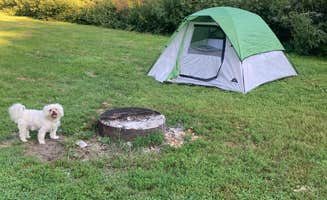Richard J Dorer Memorial Hardwood Forest surrounds the bluffs and valleys near Winona, Minnesota, offering primitive camping options in southeastern Minnesota's distinctive driftless region. The area features deeply carved river valleys with limestone outcroppings and elevations that can vary by 500 feet between ridgetops and valley floors. Multiple forest units provide dispersed camping across varied terrain, with most sites concentrated in designated management areas.
What to do
Hike steep trails: The Reno Unit trail system includes challenging vertical climbs along bluff edges. A camper notes, "This is an awesome place to hike, not a very long hike but it's steep with drop offs. Not for those that are scared of heights." Richard J Dorer Memorial State Forest Reno Unit Dispersed Camping offers backcountry camping spots that aren't clearly marked but reward hikers with solitude.
Paddle to remote sites: Crater Island provides boat-in only camping access across the river in Wisconsin. According to a visitor, "Big parties in the cove. No bathrooms no showers, just sand and water. Very busy on weekends in the summer, as long as there is no dredging operations going on." Crater Island becomes particularly crowded during summer weekends.
Bike from established trails: The Root River Canoe Campsite connects to regional bike paths. "There is a bike trail that had a fork in the road that leads right to it someone could walk, hike, canoe or kayak to access this campground," explains one camper. The site remains accessible by multiple means despite the river changing its course over the years.
What campers like
Quiet weeknight stays: Zumbro Bottoms State Forest offers more secluded camping opportunities. A camper reports, "This area is off a low maintenance dirt road. It is best to come in from the south as sometimes the gate on the river bridge to the north is closed." Zumbro Bottoms State Forest provides dispersed sites with vehicle access adjacent to hiking trails.
Flexible overnight options: The Isinours Management Unit works well for short stays. One visitor notes, "I stopped here after a 12 hour drive got set up and even walked the trails for a few miles before bed." Richard J Dorer Memorial Hardwood Forest Isinours Management Unit offers both drive-in convenience and more remote hike-in sites depending on camper preferences.
Historic camping areas: Some sites maintain connections to regional history. According to a reviewer, "This was used and built by Boy Scouts ages ago. It's still exist, however the river changed course and is further away than it once was." Many primitive camping locations near Winona show evidence of long-term recreational use.
What you should know
Steep terrain challenges: Expect significant elevation changes when accessing some campsites. One camper advises, "The hike up the hill to the overlook is a daunting one. We used a collapsible wagon to haul all the supplies up the hill."
Weather considerations: The river valleys create unique microclimates with potential for fog in mornings and evenings. Summer temperatures typically range from 65-85°F but can exceed 90°F during July and August. Spring camping often encounters muddy conditions after snowmelt.
Limited facilities: Most dispersed camping areas provide minimal amenities. According to one visitor to Root River Canoe Campsite, "It's free to stay here, and doesn't seem like people really camp here anymore. Has a pit toilet, picnic tables, and a fire ring. Ideal for tent camping via bike, kayak or canoe."
Tips for camping with families
Bring hauling equipment: For bluff-top sites with children, consider gear transport solutions. One experienced camper recommends, "We used a collapsible wagon to haul all the supplies up the hill." This preparation makes accessing higher elevation sites more manageable with younger campers.
Choose accessible sites first: Some camping areas offer drive-up options better suited for families. A camper suggests, "There are a few spaces with views you can hike in to but I opted for a spot next to my car." This approach works well for introducing children to primitive camping near Winona.
Research site locations carefully: Many dispersed camping areas have unclear boundaries. As one camper notes, "Camp spots are not well marked I stayed in the old rock Cory when I camped here, years ago." Families should scout potential sites during daylight hours.
Tips from RVers
Access limitations: Most dispersed camping areas near Winona have restricted vehicle access. One camper notes, "This is off a low maintenance dirt road." Large RVs cannot access most forest roads in the region, with vehicle length generally limited to under 25 feet.
Parking constraints: Even accessible sites have limited parking. According to one review, "There is a parking spot near a known dispersed camping site with easy vehicle access next to it." Small trailers and truck campers fare better than conventional RVs in these forest settings.
Plan for self-containment: No dispersed camping areas near Winona offer hookups or dump stations. Campers must pack out all waste and bring necessary water supplies, limiting most RV stays to 1-2 nights without services.


